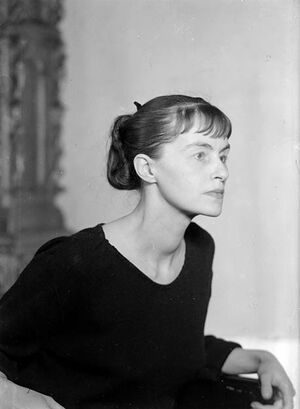
‘One of the things that always troubled me about the fascination with madness and the intertwined eroticism and death that always pervaded the Romantic and Surrealistic sensibilities was that they were almost always expressed by people who seemed to be celebrating those things without having known their cost in personal suffering. I’m not trying to apply some kind of politically-correct standard to the appreciation of such works, just pointing out that while some were idolizing the dark underbelly of the human psyche, others were helpless to it, and found nothing remotely romantic about the experience.
‘Unica Zürn seems to have been one of the victims. From 1953 until her death in 1970 she was close to one of the most important Surrealists, Hans Bellmer, living with him in Paris and posing for some of his notoriously disturbing pictures. She came to become dependent on him, and not long after he was hospitalized for a stroke and broke off their relationship (he believed he could no longer care for her in his condition), she threw herself out of the window of the sixth-story apartment they shared. She had been suffering from her own decline for some time: not long after meeting fellow artist Henri Michaux in 1957, she began to experience one shattering episode of mental upset after another that culminated in her self-destruction.
‘Michaux himself played a central part in these breakdowns: there was something about him which reminded her of a childhood fantasy that she had entertained, and his presence fueled the writing of two works: The Man of Jasmine, most explicitly about the Michaux-image, and Dark Spring. The latter has been described as a kind of erotic autobiography: a portrait of the artist as a young girl, and also a young corpse. Zürn killed herself not long after writing it, and in a manner so strongly redolent of the death of the girl within it that it became hard to see the story as little more than a kind of fictionalized suicide note. And yet at the same time it is more than that: it can be read entirely outside of the context of her life, and it has a stark power that stays with you even when removed from that context.
‘What makes it work, oddly enough, is that it is a remarkably short and compact story — barely 115 pages of large type — but the details that make up the story are so sharp and well-chosen that there scarcely seems to be anything more to add. It presents us with the life, and death, of a young girl — barely pubescent but with an erotic haze suffusing everything in her life, including her obsessive devotion to her father. Her mother is insufferable; her brother subjects her to various sexual torments and eventually rapes her; gradually, she recedes inwards and finds greater satisfaction in fantasy worlds than in her daily life. The fantasies themselves reek of depravity and torment — but at least a kind of depravity and torment that are of her own creation.
When she finally does turn her erotic obsessions back outwards, they fixate on a handsome young man — an adult, where she is still really only a child to the rest of the world — whom she encounters at a public swimming pool. There is nothing outwardly sinister about him, but again, he is an adult, and she is not, and from that comes a wall that she finds impossible to surmount. And from that rebuff her thoughts turn inwards once again, to find what consummation she can in fantasies of enacting her death for real. The last scene in the book has been widely compared to Zürn’s own suicide, although she seemed less to be “rehearsing” anything than admitting she was helpless in the face of what was, in her mind, a foregone conclusion about her life.
‘If the book is so relentlessly bleak and ends on such a phenomenally closed-ended and nihilistic note, why read it at all? For one, the compactness of the story alone makes it into quite an achievement: it’s a little exhilarating to see Zürn pack so much about her character into so few words, to make one sentence do the work of a paragraph, and to evoke this girl so sharply without needing more space than she does. The other reason is more general than that: we might want to read such things for the same reasons that people are compelled to write them — because places like this do exist within us, and if someone can not only talk about them but do justice to them, then the results are aesthetically exhilarating even if they imply ghastly things. That was after all a large component of what the Surrealist mission was: to dive into the unconscious, rescue the things that might normally be thrown away by the waking mind, and make them into the substance of their art. What makes Dark Spring so hard to put out of mind is that it shows Zürn diving into her dreamworld and coming up with nothing less than her own cenotaph.’ — Serdar
_____________
Hans Bellmer’s photographs of Unica Zürn
‘Perhaps the best-known collaborations between the artist Hans Bellmer and Zürn are the works where he tied her up tight so that her body greatly resembled a scored piece of meat, also resembling his dolls’ appendages. She was also the star of several pornographic photographs, many that made their way into Geoges Batatille’s illustrated version of Story of the Eye.
‘In true Surrealist fashion, she is treated as an object and not as a woman, a headless body readied for manipulation. Her pleasure from this, though, speaks to her being very free, even feminist in the face of a movement and a time where that was rare and criticized. The fact she writes about these things makes her even more of a trailblazer, a forerunner of the movement actually doing what many of the male Surrealists could only inflict.’ — DOLL WORK
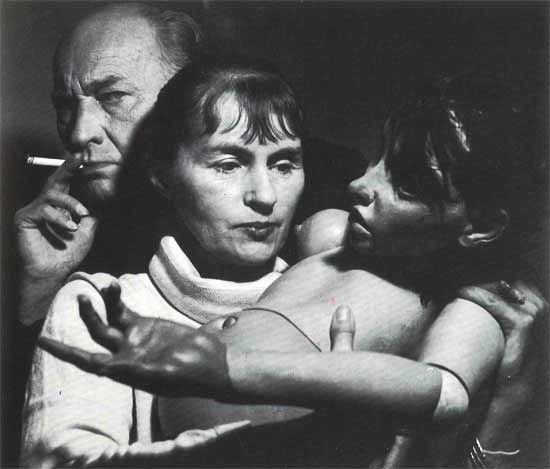
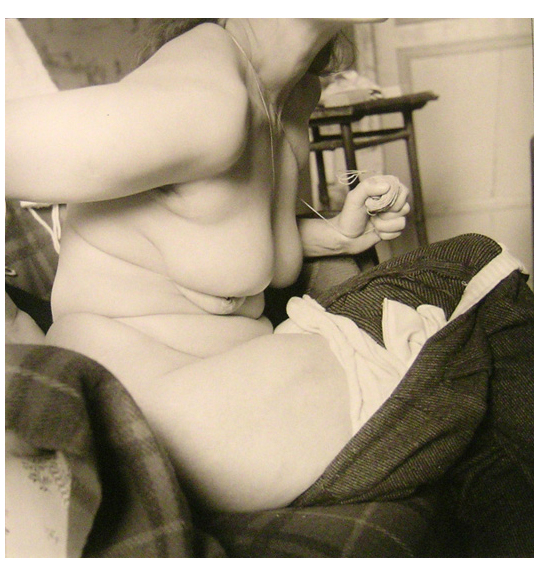
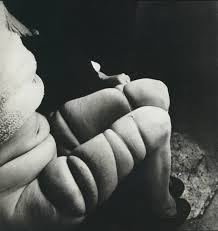

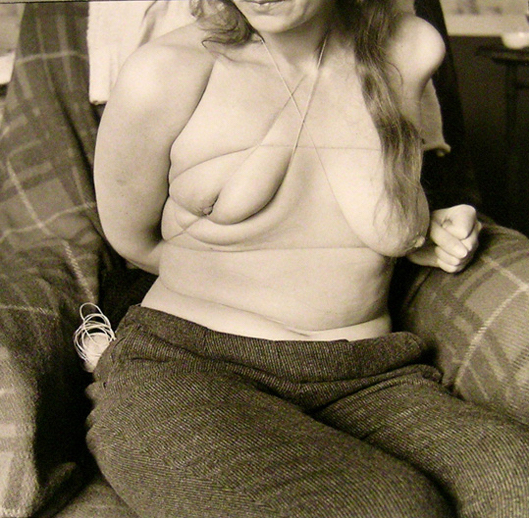
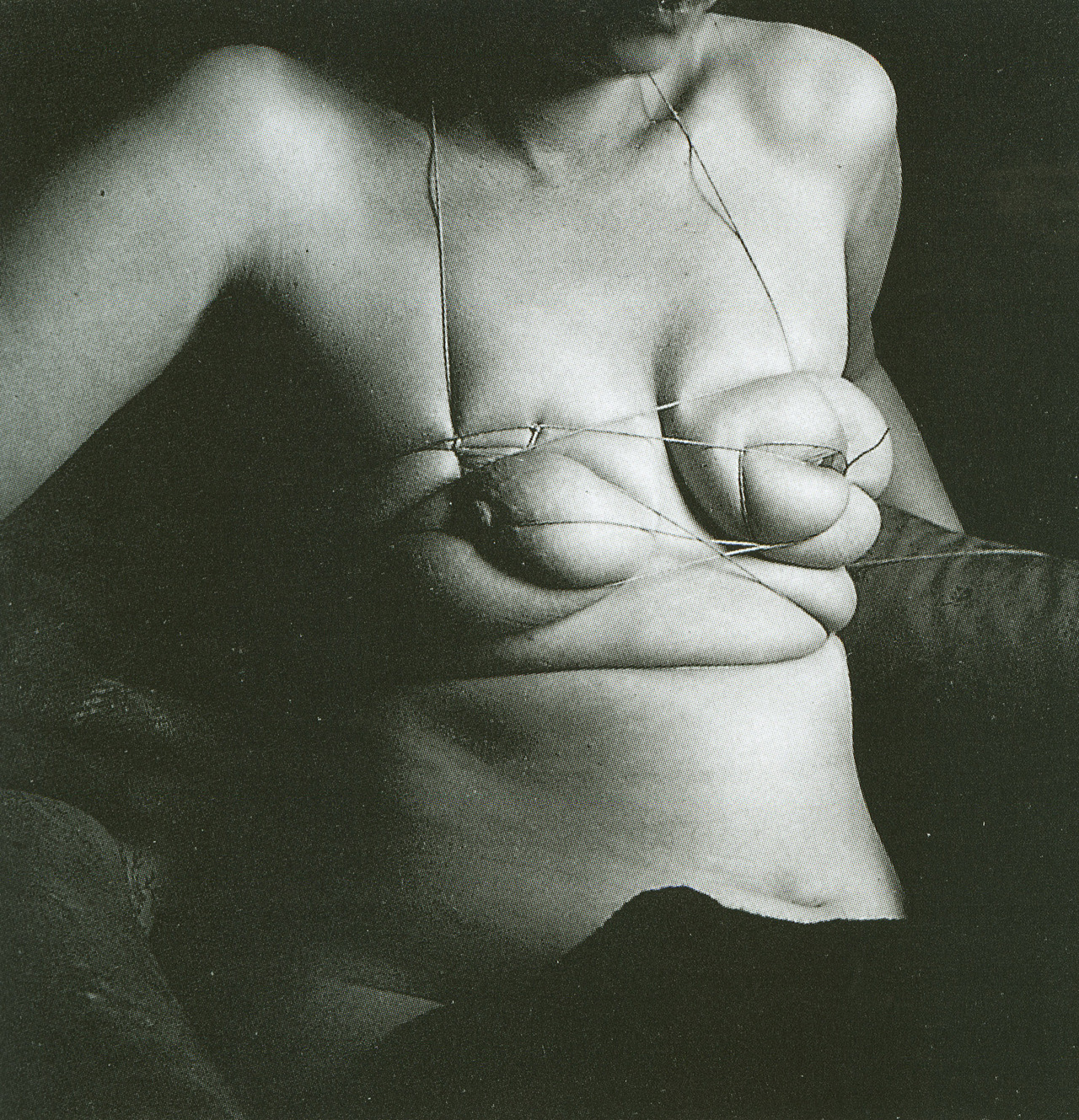


____
Further
‘A STONE FOR UNICA ZURN’, by Gary Indiana
‘The Hallucinatory Terror of Unica Zürn’, by Blake Butler
The Chimeras of Unica Zurn
TWO HALVES: UNICA ZÜRN
Unica Zürn, Bellmer et Perec
UNICA ZÜRN: “HERE IS THE DOLL …”
Bound: HANS BELLMER and UNICA ZÜRN
Unica Zurn, Solfege and Spectacle
Unica Zürn: Nine Anagrammatic Poems
Unica Zürn @ goodreads
Book: ‘Unica Zurn: Art, Writing and Post-War Surrealism’
Audio: À la recherche d’Unica Zurn
The automatic drawings of Unica Zurn. (1916-1970)
The Semiotics of Schizophrenia: Unica Zürn’s Artistry and Illness
An Interview with the Lovely, Yet Deceased, Unica Zürn
MAD WOMEN: Hedda Gabler, Unica Zürn and Leonora Carrington
French Surrealist Unica Zürn’s The Trumpets of Jericho is a powerful tale of maternity and depression
Fragmentos de la vida y obra de Unica Zürn
The Syntax of Anxiety: Unica Zürn’s Novella
About what: Unica Zurn
Buy ‘Dark Spring’
_____
Extras
Unica Zürn by theakky04movies
A MOVIE FOR UNICA ZÜRN
UNICA ZURN
UNICA ZÜRN – ICH WEISS NICHT, WIE MAN DIE LIEBE MACHT
________
Last Notes

“The last “notes” of German author and painter Unica Zurn, written in 1970 some months before her suicide, confront the “family curse.” Already in childhood she seemed to know that she too would end her life like her mad uncle Fallada and her adored stepmother Orla Holm. Writing, in “The Whiteness with the Red Spot” (1958), “This life has not become my life,” she formulated a motif of both her drawing and writing. Her autobiographical texts are never written in the first person, but always in the third. Like a camera, she takes a picture of her actions, writes about herself as though about some nameless, enigmatic, other woman. Always loyal to the inner difference between “I” and “she,” Zurn never attempted to smooth over her strange, singular distance regarding herself and her life. “Impressions From a Mental Illness,” an account of her illness and sojourns in psychiatric hospitals published in 1967, is recorded in the tone of a distanced witness. At the same time, she claimed not to have written one sentence that did not correspond to her life. In the end, in 1970, she wrote: “How poor has her life become”. At this point, after the separation from Hans Bellmer, her companion since 1953, and after she decided to separate from a life that had become resolutely aimless, she nevertheless seemed to catch a glimpse of the possibility of a final breakthrough. Faced with a self-imposed deadline of several months, she succeeded in producing a narrative that broke with her former concept and proceeded to follow another order, one born of poverty. She goes back to untold coordinates in a language that documents her ever-beckoning erasure. The last notes, which leave off with her voluntary death, before extension and interweaving could take over, reveal memory to be a seldom functioning machine that, faced with a deadline, wants to tell the untold in the form of intransitive images. These images seek to cross over into oblivion or toward the prospect of yet being experienced in the future.
Zurn’s body of work opens up the interior of a perceptual system of madness. The texts are located at an intersection, a point of transfer. Madness becomes the supplier of literature, literature transports madness. Both drawings and texts show the “image processes” (Zurn) or hallucinations haunting her. “I’m haunted as though I were the only home for something unknown”. It is not she who writes or draws, as images “stream in” or “arise”. A dictation she feels compelled to take down circumvents “sublimated elaboration” (Kristeva). For Zurn, some thing or other–what Lacan calls extimacy (“extimite,” a foreign body, composed of what is intimate)–seems to take charge in the missing place of authorship and sublimation. She is remote-controlled and the rote observer of a delirium that runs on ahead like a movie. She writes down what can be caught. The notes resist, as pure record, the inaccessibility of madness.
There can be no doubt, however, that madness has a method. Even the smallest task becomes cryptography.
‘She asks the daughter to get the box with the money
and to count the money; she herself is not able. One
looks at her in amazement. In the meantime the nurse
comes back and she goes into the kitchen and looks at
the enormous, fat leeks rising up from a casserole
dish that’s too small, in which there is only a little
water. This meal will never be ready and she feels herself
incapable of cutting the vegetable into pieces. This problem
grows so monstrous and is so unsolvable that she, overwhelmed
by vertigo, goes back to the bedroom, starts to stagger and falls
to the ground.’
In other words, changes of dimension foreground inconspicuous things. The world of things spreads out. Proportions distort themselves in a surreal way. The transformation of material reality serves to close the narrator off from her surroundings.
The texts preceding her last notes move along the edge of a psychotic discourse, and can be described, following Kristeva’s Pouvoirs de l’horreurs (1980), as speech based on foreclosure, the virulence of which dislocates the opposition between consciousness and the unconscious. “The unconscious contents remain locked out here but in a bizarre manner: not radical enough to allow a solid differentiation between subject and object and not with sufficient selectivity for the unfolding of a position of defense, refusal, but also sublimating elaboration. The contents, which are normally unconscious for the neurotic, become explicit now.”
Madness constantly deciphers itself within a realm of unintelligibility. Although Zurn’s writing and drawing border conceptually on automatic writing and drawing, she nevertheless also developed a certain competence for selection. Cutouts of inner images are edited from a continuum we will never get to know. A natural metonymy is replaced with an artificial montage. With the montage, there appears attribution of meanings. But no pure, immediate mimesis results, but rather a simulation and translation of inner “image processes.” Zurn’s alleged female “non-authorship”–the conversation of another agency through her, the dictation of her illness–is also a rhetorical trick that is supposed to withhold from the reader the difference between madness and literature. Madness is neither told from the perspective of rationalism nor does it speak with its own voice. As the manuscripts show, there are decisions made in advance, revisions, deletions, several versions, as well as a general orientation toward the program of surrealism. Regarding the best pages, one gets the impression of an unfolding signifying chain, a mad externalization of memory, without any obstacle getting in the way.
In contrast to Zurn’s best-known texts from the 1950s and ’60s (The Witches’ Texts, the “Anagrams,” and The Man of Jasmine), the last notes perform a realization of separation. Zurn seems in the end to break with the surrealist concept of a blending of boundaries between madness and reality. The prospect of their amalgamation has been withdrawn. The posthumously published leftovers bear the marks of a violent erasure that will not be ignored. Whatever is able to grab us as hallucination, promise, fiction, has vanished. With the separation from Bellmer, her “other” or “symptom,” and with the decision at the same time to end her life, the (Lacanian) real as the nothing of the other becomes manifest, one of whose signs is the separation of tenses and times. Present, past, and future, which were once used interchangeably in the world of hallucination, are assigned different places. It is this process of separating out that distinguishes the last notes from all preceding texts. Now the emptiness can be represented, not sublimated. The former delusion of signification, which functioned to screen this emptiness, leaves off. What is registered now is what was missing before: the empty reality that is no longer modulated by any fiction or alienation. But in Zurn’s late, nearly dispassionate narrative style, which departs both from the art of interpretation and from madness, there remains a kind of consolation.
They smoke – the smoke becomes thicker and thicker around them. The surroundings disappear, only their two pale, tired faces are still visible. Suddenly they are the only two remaining in this world of pain. Nobody is there – the house, the world – everything is emptied out, gone are the living and the dead. An endless solitude and probably an eternal night without a morning to follow. They are silent and smoke. It is deathly still in the house, in the world. What sadness life – what solitude – death.
She has left the space of madness and accepted instead the place of the dead.
In the process she comes up with divisions that she had previously rejected. She cuts her life into pieces–her time in Paris, her time in Berlin, her encounter with Bellmer – and attempts to maintain a simple verbal construction of life and time. She resists the dictation of madness, the hallucinations and paralysis, and permits herself access to individual memories, which, once again but from a different standpoint, refer back to the origins of her system of madness.
The last fragments return to particular situations in her life that signified an original break. A few untold memory-images detach themselves from the emptiness that encloses the memories. With the deadline, tightening condensation sets in. “At the end of one’s life”–as Benjamin writes in “The Storyteller” (1936)–“a sequence of pictures is set into motion, unfolding views of oneself, in which one has, without knowing it, encountered oneself.” Benjamin conceived the emergence of memory-images as a form of “self-encounter.” “To the highest degree, it bears the stamp of the critical, dangerous moment”.
Without question, the memory of the sight of a five-month-old “embryo” is this image of horror. In the early 1960s, after a series of failed attempts to abort the far too developed fetus, a physician in Berlin gives her “a box of quinine.”
‘At the climax of pain, she goes to the toilet and gives birth at this sad place to a big embryo. No blood flows. She holds with horror and at the same time with admiration this unfinished being in her hand that looks like a very old, nearly Aztecan object. Horrible picture how this solemn and strange-looking being sinks into the darkness of stinking, subterranean canals.’
What is nearly impossible for her to narrate – the unnamable violence against bodies–comes to be told in one of the last possible moments. The dynamics of the writing process is, in the end, a “retouching” of irreversible separations, here in sight of the “incomplete,” “solemn and foreign-looking being.” In the end she seems to cease merely receiving dictation and works with her own suffering, grants it discourse. No longer in an autoerotic or self-enclosed way as during the phases of recording hallucinations, her discourse reaches another type of image, another psychic layer. It seizes a moment of crisis and emphasizes the separating line as a leftover set aside for writing.
For Zurn, there is one motif that always returns. It refers back to the origin of her system of delusion in her most fundamental operation: the splitting apart of face and body. In the context of her individual mythology, she dates or mystifies the “beginning” of her system of madness back to the fixation on the “solemn and foreign-looking,” yet beautiful face of a man. She calls this apparition the “man of jasmine.” The first time she sees him, in a “vision,” she is six years old, and she will go on encountering him again and again, now in a movie (Jean-Louis Barrault in the 1945 film Les enfants du paradis), now in reality: it is the face of Bellmer, the face she follows to Paris. As she remarks, she has grown ever more like this face herself. In Dark Spring (1967), Zurn relates how she, as a twelve-year-old girl, eats the photograph of a young man to keep the grownups from discovering it.
‘She puts the photograph in her mouth, chews it up carefully and swallows it’.
She incorporates the man as her imaginary double image. Bellmer followed this curve:
‘She carries the picture of Hans in her eyes, ears, hair, and in her body and in her soul: he was omnipresent to her – she was under his spell – wherever she walked’
In Paris, she meets the mystery man also in the incarnation of Henri Michaux:
‘Later she experiences the first miracle of her life: in a room in Paris, she faced the man of jasmine. The shock of this meeting was so powerful that she could not recover from it. From that day on, she begins ever so slowly to lose her mind’.
It is a face associated with something inscrutable, an image with a staying power that can’t be exhausted. As Benjamin once put it, “For everyone there exists an image over which the whole world disappears… for how many does it arise out of an old box of toys?”. The evocation of many images gives way to their condensation in one inscrutable image that replaces all the others and lets them go. The mystery of the face in Zurn’s poetic system–twice identified as a “Chinese face” -signals the narrator’s preferred mode of love: adoration, love at a distance, that of the bodiless kind. The man of jasmine is paralyzed; he sits in a wheelchair. His image always arises in a specific constellation that repeats itself in a nearly somnambulist manner. The mask of the esoteric love is a screen image, a screen memory, which points to something behind it or invisibly connected to it. “Object” and “abject” are inextricably entwined. On the first page of The Man of Jasmine, the narrator, immediately before mentioning the “vision,” recounts a dream involving a well-known surrealist motif: the dreaming woman walks through a mirror on the wall. She passes through and finally stands in front of a table. On the table is a small white card. “As she picks up the card to read the name on it, she wakes up”. The dreamer knows that there is a name written on the card, but this name, this attribute, stays inaccessible to her. The decipherment fails. Shortly afterwards, we read:
‘Filled this morning with an inexplicable loneliness, she enters her mother’s room in order to get into her bed and return, if possible, to the place where she came from–so as to see nothing more. Suddenly, a mountain of lukewarm flesh, enclosing this woman’s impure spirit, rolls over on the horrified child, and she flees forever from the mother, the woman, the spider! She is deeply
wounded. ‘
The next sentence:
‘Then her vision appears to her for the first time: the man of jasmine! Never-ending consolation! Sighing with relief, she sits down opposite him and studies him. He is paralyzed. What luck! He never leaves his seat in the garden where the jasmine blooms even in wintertime.’
The violation of boundaries identified with the mother immediately precedes the first appearance of the hallucination. From this point onward, the “screen” with the face of the other will always be called up whenever an unbinding of affects breaks through the protective layers. The visual sense protects against the memory of the body and the affects it holds in store. The “face” occupies the threshold between image space and body space, and splits them apart. The screen solution is activated whenever there is a repetition of the sense of being overwhelmed. Although the two scenes always follow one another, the gap between them and their necessary connection is suspended, disassociated. There is no passage to the zero degree of meaning. Through the symbol of the face, the text gains a figure, a facade–and hides a radical moment of loss, the eclipse of signification.
One of Zurn’s psychiatrists, Rabain, who worked at St. Anne in Paris, remarks likewise: “Violent breaking into a body, which is under attack by a bizarre object, invested with intolerable emotions – an obscene and dangerous object like the mother tongue.” The transgression, traced by the protagonist to her sixth year, destroys and contaminates the body’s frontiers – at the level of incest – and becomes the catalyst for biography, work, and the system of delusion. One will never know if this scene is the “origin” of schizophrenia or already part of the system of madness (as an inner image). Traumatization is often missing its origin in time. One finds oneself constantly before or after the beginning. What happens, or is said to, can also always be a consequence, and again a consequence of consequences, until the chain loses itself in the horizon of the “too early.” Even if the violation, as reported in the text, took place “in the sixth year,” it is already mediatized in passing through the memory. And so the question remains: how could this event take on such importance, such doggedness?
For her, there remains the saving clause of a distant father, who travels a great deal. The adoration of an inscrutable face remains in her imagination, like the body bound to a wheelchair, unchangeably situated in the same place, in white jasmine. A delegate of the father without a body, someone whose face counts for her – who cannot leave her, dependent as he is, like herself, on assistance–becomes the model of love she holds up to the diffuse body of the mother, a model that won’t permit the regression. This image is always called forth whenever a return to the merger with the mother’s body, which has never completely broken away, takes place. The advantage of this inner splitting is that another solution doesn’t have to take place: the slow, step-by-step separation from the mother. The connection as well as the break with her couldn’t be integrated; the mother survives, internalized, as an overpowering, contaminated being, as the one who dictates. The logic of this traumatic “break-in” determines the quality of Zurn’s psychiatric institutionalizations. In the hospitals she is surrounded by the polymorphous-perverse female bodies she always described in her texts about her hospital stays, and which she drew (with Chinese ink) as overlapping, interchangeable bodies. The hospitals connect her atmospherically with the unconscious image of the mother. The corridors are lined with the openings of a memory-less memory. In one of the last letters to Herta Hausmann, she writes from Chesnailles: “Weather fine – [in French] as for me, the melancholy resulting from that dismal sojourn in the belly of Helene Helly-Zurn, my mother, still remains …”. She spends her last ten years divided between two places or scenes, the contour-less, regressive place of the mother (Wittenau, St. Anne, Maison Blanche, Chesnailles) and Bellmer’s Parisian apartment, home to one of the many bearers of the “Chinese face.”
The singular image of this face would seem to be without history. That would be its protective function. But the texts show that the timelessness of the face is marked from the beginning by withdrawal. It is the discrete sign of the destruction and of the wish for destruction that has inscribed itself in Zurn’s body. Overwhelming, excessive, overlapping, never graspable by the one thus seized, the body is disturbed or destroyed at its borders, which never seem functional or protective. To the very end, Unica Zurn’s memoirs (for which she contrived the neologism “Memorien”) represent a solitary attempt to re-inscribe her own bodily contours with repetition, narration, and drawing–but the countervailing forces were so much stronger.” — Rike Felka
_____
2 manuscript pages
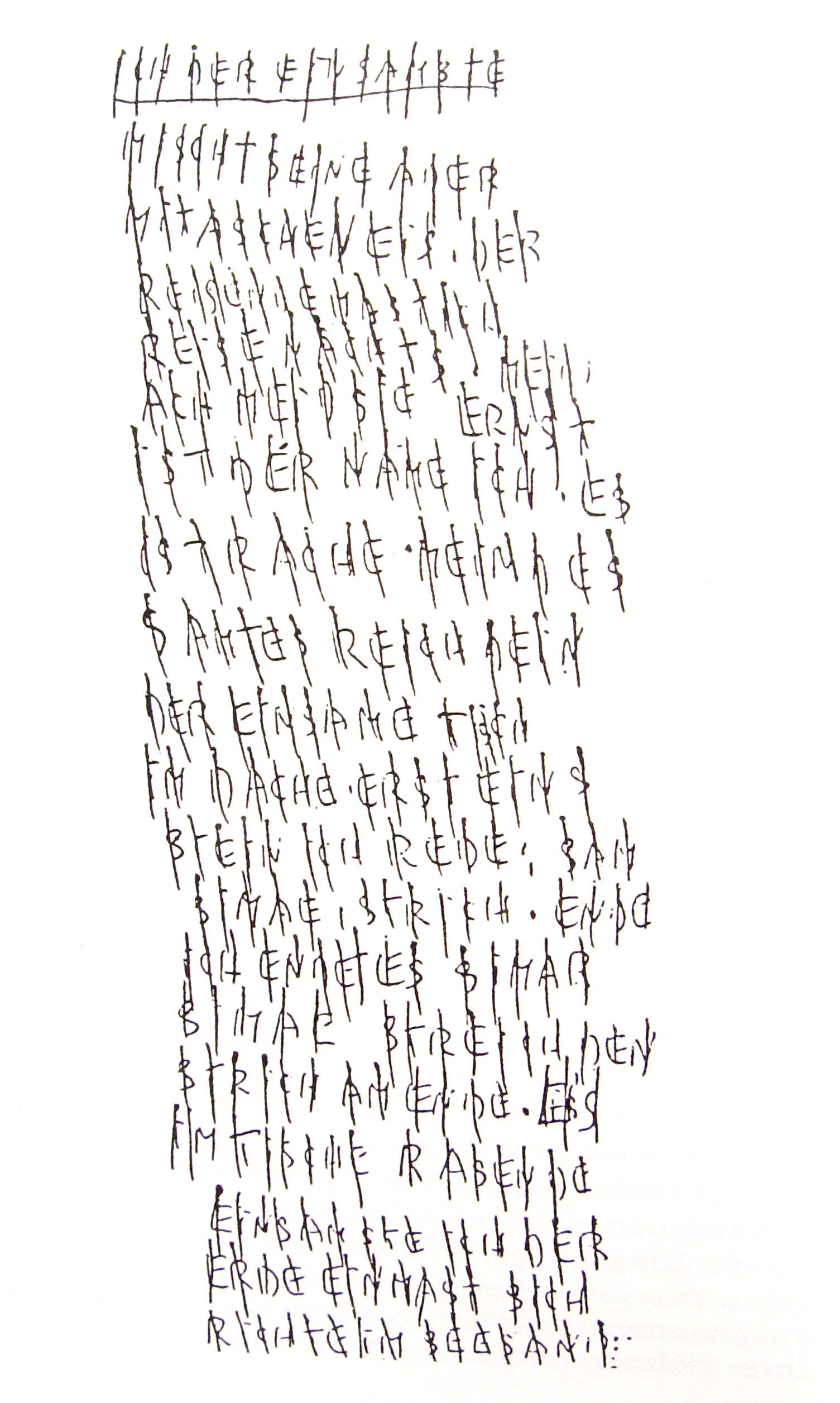
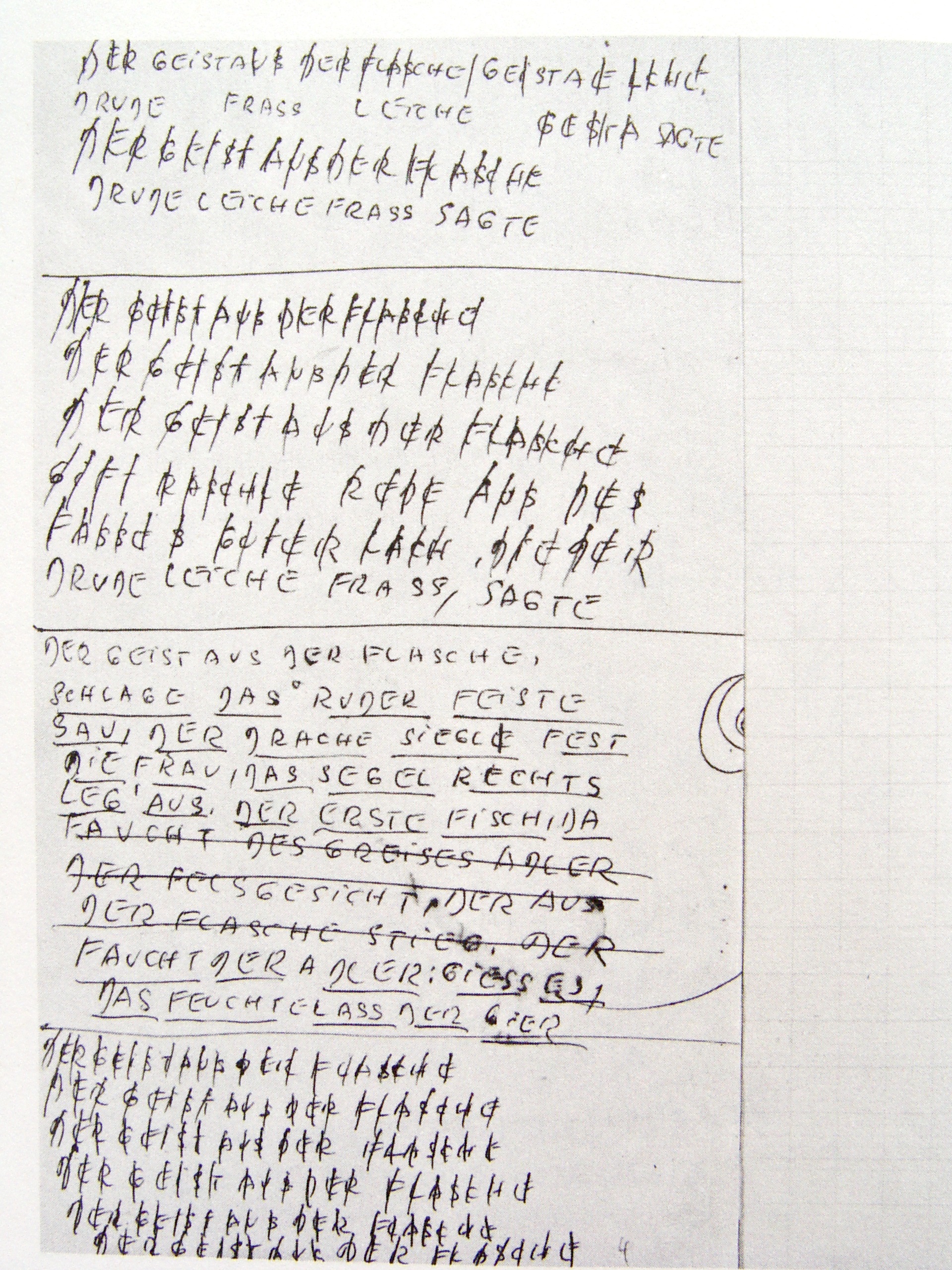
___
Book
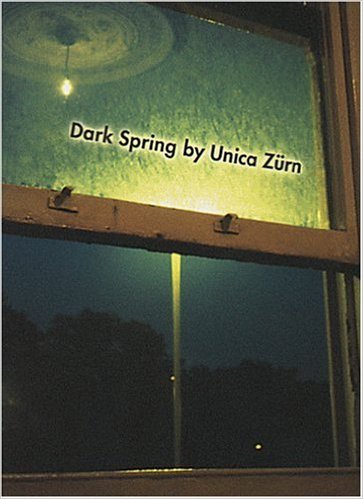 Unica Zürn Dark Spring
Unica Zürn Dark Spring
Exact Change
‘Dark Spring is an autobiographical coming-of-age novel that reads more like an exorcism than a memoir. In it author Unica Zurn traces the roots of her obsessions: The exotic father she idealized, the “impure” mother she detested, the masochistic fantasies and onanistic rituals which she said described “the erotic life of a little girl based on my own childhood.” Dark Spring is the story of a young girl’s simultaneous introduction to sexuality and mental illness, revealing a different aspect of the “mad love” so romanticized by the (predominantly male) Surrealists. Unica Zurn (1916-1970) emigrated in 1953 from her native Berlin to Paris in order to live with the artist Hans Bellmer. There she exhibited drawings as a member of the Surrealist group and collaborated with Bellmer on a series of notorious photographs of her nude torso bound with string. In 1957, a fateful encounter with the poet and painter Henri Michaux led to the first of what would become a series of mental crises, some of which she documented in her writings. She committed suicide in 1970–an act foretold in this, her last completed work.’ — Exact Change
_____
Excerpt
Each time, she finds herself tormented by her terrible fear of the rattling skeleton of a huge gorilla, which she believes inhabits the house at night. The sole purpose of his existence is to strangle her to death. In passing, she looks, as she does every night, at the large Rubens painting depicting “The Rape of the Sabine Women.” These two naked, rotund women remind her of her mother and fill her with loathing. But she adores the two dark, handsome robbers, who lift the women onto their rearing horses. She implores them to protect her from the gorilla. She idolizes a whole series of fictional heroes who return her gaze from the old, dark paintings that hang throughout the house. One of them reminds her of Douglas Fairbanks, whom she adored as a pirate and as the “Thief of Baghdad” in the movie theater at school. She is sorry she must be a girl. She wants to be a man, in his prime, with a black beard and flaming black eyes. But she is only a little girl whose body is bathed in sweat from fear of discovering the terrible gorilla in her room, under her bed. She is tortured by fears of the invisible.
Who knows whether or not the skeleton will crawl up the twines of ivy that grow on the wall below her window, and then slip into her room. His mass of hard and pointed bones will simply crush her inside her bed. Her fear turns into a catastrophe when she accidentally bumps into the sabers, which fall off the wall with a clatter in the dark. She runs to her room as fast as she can and slams the door shut behind her. She turns the key and bolts the door. One again, she has come out of this alive. Who knows what will happen tomorrow night? . . .
Sometimes, when Franz visits, he makes her laugh so hard that she ends up wetting her panties. The smell of it attracts the dog, who puts his head between her legs. This gives her an idea. She goes down to the basement and over to the dog pen, where she lies down on the cold cement floor with her legs spread apart. The dog starts to lick in between her legs. The cold only increases her sense of pleasure. Feeling the ecstasy, she arches her belly towards this patient tongue. Her back hurts from the hard stone. She loves to be in pain while enduring her pleasure. She is greatly aroused, even more so because of the possibility that, at any given moment, someone might come to watch her. Through the door she can hear the sound of her father’s secretary typing. While she yields to the dog’s tongue for hours, her brother discovers something new upstairs. Sitting at his mother’s dressing table, he busies himself with the electric vibrator their mother uses for her beauty care. This vibrator stimulates whichever part of the body it is applied to. The mother massages her face with it; the son puts it into his open pants. When she comes upstairs from the basement, weakened and dizzy, she sees her brother lose his semen, his head thrust back and his eyes closed. The sky has darkened. There is the threat of a thunderstorm and the atmosphere is tense. The adults pay no attention to the two children, who have nothing better to do than to keep experiencing, over and over again, this indescribably powerful feeling.
*
p.s. Hey. ** Dominik, Hi!!! Yeah, I remember what it was like when I was preparing to relocate to Paris. An intense combination of exciting and very stressful. We’re extremely happy with the editing so far, yes. It’s early on, but I really think the film is going to be amazing. I’d read love’s bio just to figure out what the hell that title means. Love making time not only fly but caw like a crow, G. ** Misanthrope, Any fun water cooler stuff yesterday? ** Mildred, Hi. Oh, your friend must have met her at the ‘PGL’ screening in LA where she did a concert to close out the event. She’d like being thought of as a witch, I’m sure. Most of my LA friends are going to Dodger games all the time right now. I miss that. I haven’t heard ‘Venus In Leo’ but I’ll get on that. Ah, gotcha, just remodelled, okay. That’s weird enough. Cool that you’re hard into the work on the album. I can totally relate, what with the film assemblage. So sparkly. I really like the lyrics, thank you. I can’t wait to hear their score and voice of God. ** Darbz 🐘🎪, HI! I should have figured about the poor little elephant. Motherfuckers. The clip totally sent and, yeah, it’s gorgeous. I’m going to watch it on repeat when I get back from editing today. Petr Pevlesnky, yeah, he did some intense performance in Paris a few years ago, but I can’t remember what it entailed. When performance art is great, which is rare, it’s kind of the best form. I do want to read something you wrote, of course! You’ll have to be patient with me at first though because I’m editing the film from morning to night every day, and I am either doing that or kind of zombified, But, yes, I do! Lovely! ** Nick., Hi! Up? I’m just film film film right now. That’s both my up and my down. Psychobabble from whence? I always loved writing since I was a little kid, but I didn’t necessarily understand that that could be my life at first. When I was 10, 11 years old I wanted to be an actor. My parents even got me an agent who turned out to be a scam artist, and I took acting lessons and stuff. But I figured out I was not an actor pretty quickly. And then writing swallowed me up. I think you sound naturally custom-made to be an artist, dude. All those qualities are the essentials. What kind of artist would be your ideal? You can be an artist and love dudes, etc. That’s the great thing about being an artist. Your time is your own. Thank you for being my friend too, it’s a real boon. I’m a person who generally thinks of food as fuel, and I’m vegetarian/vegan, so I just shove a bunch of tofu and seitan and stuff in the microwave then wrap it in a tortilla and eat it. I did have a superb pizza last week at this place called Sette in the 10th arr. Highly recommended if you ever come over here. Do you eat breakfast? If so, what? I don’t. I just drink coffee. See you soon. ** Bill, Oh, wow, that’s so interesting to discover that you’re a carnivorous plant farmer in addition to your other wonderments. Thank you a lot for the links! I’m rushing to get out the door to start the day’s film editing but I’ll peruse the goods when I get home. Awesome, thank you so much! ** Mark, Wow! I have to tell you I am so impressed that you designed theme park rides. That is perhaps my ultimate dream profession. Yes, I know IAAPA. I’ve been to one or two of them. I’m a theme park obsessive. I’ve met Kristian Hoffman a few times, but I don’t really know him well. I like his music, and he’s very funny. Ah, best of luck to Yony on his new film, and I’ll obviously be curious to see that. ** _Black_Acrylic, Ha, I used to play Game of Life all the time when I was kid. Memories. I think it must have been pretty good fun. And maybe torturous. I do like torturous things. ** Cody Goodnight, Hi! I’m good. Busyness is good. I’m very busy myself right now. I adore roller coasters, but I’ve never played Roller Coaster Tycoon either. Weird. Thanks for reminding me that I really want to see ‘The Amusement Park’. I keep forgetting to watch it. I love ‘Martin’ too. I’m going to have to think about underrated queer films because I think there are probably many, many, and I’m having to rush out the door in a minute. ‘Pornography’ is my favorite Cure album by miles. ‘Strange Day’: so great. ** Jeff J, Hi, Jeff. Um, not revelations per se, but we’re kind of nose-to-grindstone constructing a solid first draft so we’re pushing forward mostly. I think it’s working even better than I had imagined it would, but once we have a whole cut we’ll go back and watch it, and then I’ll know. I was wondering how one could do a Bookworm book considering the insane amount of great interviews. But that thematic sounds good, solid. The 17th/18th should work, yeah. Let me know on your end. Hm, I’ve had Ashley in posts, but I … don’t think I’ve done a whole post about him, or maybe many years ago? It’s a great idea. ‘Perfect Lives’ is my favorite of his works. Nice. ** Guy, Hi, Guy! I’m good, how are you? I’m sorry about the huge posts. Well, actually, I’m not sorry at all, ha ha. Err, no, I can’t think of how to recreate that thrill. Go find a more exciting writer? It’s certainly very possible. Thank you for saying that. What’s happening with you? ** bruno msmsmsm, Hi! How did you do on the exam? Or when will you know? My weekend was just kind of chilling to take a break from the otherwise non-stop film editing days. Nothing too exciting to report. Yeah, I’ve been co-making films for about, uh, ten or more years, I guess. I love it. I’m glad the post matched up with your hate. Lovely to see you! ** myneighbourjohnturturro, Hi! Yeah, I’m kind of relentless in my search for new things to make. Oops, I hope the new bf sees reading the Cycle as a further enrichment of their adoration of you. Haven’t heard the Model/Actriz, but I’ll definitely get it. I like the new Lana Del Rabies too. Her best, I think. I have a piece of it in the next gig post. I will at least look for a photo of Harsh Symmetry, ha ha. Have a superb … what is it … Tuesday! ** Okay. I thought I would direct the blog’s spotlight onto Unica Zurn’s amazing novel ‘Dark Spring’. What do you think? See you tomorrow.




 Now available in North America
Now available in North America 
Hi!!
Yeah, and I can imagine that moving to Paris from the US was a whole lot more difficult. We’ll just drive to Vienna with all our stuff and the dog, and that’ll be that. But still. “Exciting and very stressful” sums my attitude up pretty well.
Ah, that’s so very good to hear – that you’re happy with how the film’s shaping up! I absolutely cannot wait to see the final piece!
What a poetic love today. I really love it. Thank you! Love allowing you to watch any movie for the first time again – which one would you choose? Od.
I’ll send my next update from Vienna, as soon as we’re all settled and have proper internet connection and everything. Wishing you perfect editing flow in the meantime!!
Hi Dennis, you’re so modest. The truth is I haven’t been able to find any other books which are even remotely as exciting as yours. Do you have any suggestions? Contemporary literature has become a real bore: puritanical, self-conscious, produced by and for basic bitches … I read far more intricate stuff when I was in elementary school… It’s a real concern, and since the disasterous job situation, I’ve been feeling really lost & confused, not sure what to do in terms of my future “career”. I went to a rave at the weekend, but realised I hate doing drugs and staying up all night… I still feel really lethargic… Glad to know you’re feeling good. I love, love, love your picture in Airmail.
Hey Dennis, hope the film stuff is coming along well after shooting in the states recently. I believe you guys were shooting in Joshua Tree? That’s in the general area of where I used to live in California. Ever visit the Salton Sea or Bombay Beach? I grew up there and really explains some stuff about my art hahah.
Hope all is well and stress free.
I am a big fan of this book and of Zurn in general. Maybe it’s simply the passage of time, but when I read her words these days I find more humour there than I ever did previously. The Man of Jasmine is also great, though you’d have to look pretty hard to find the laughs in that one.
Much of New York (including City Hall) experienced an Internet outage yesterday due to a broken fiber optics cable. I didn’t have Wi-Fi access (or the ability to stream video on my TV) for 11 hours. When I could finally check all the E-mail I’d received during the day, the amount of useless crap really hit me.
Lately, I’ve been feeling like I have exhausted the potential of LMMS, the DAW I use to produce music. In the next week, I plan to buy a used laptop which I can devote entirely to music, and then download several other DAWs, including apps designed for making experimental music.
When do you think a rough first cut will be finished?
Hi Dennis, what’s the deal with Marina Abramović? I read in an interview that you can’t stand her.
Zurn is one of my major inspirations! Great to see this spotlight. I love those disturbing fractal drawings in the first video. I was lucky to be in New York when the Drawing Center had a show of the drawings. Just fascinating to get lost in the details.
Hope the editing continues to go well, Dennis. I saw this lovely ’90s artifact last night:
https://roxie.com/film/virtue/
One of those beautifully messy experiences. With VR goggles! It’s pretty funny that Apple made their announcement on the same day.
Bill
hi Ahh. guess what? I found a DEAD bird! It was sitting in someone’s bucket and they let me have it! I cant taxidermy it sadly cuz it has no skin just a thin membrane. It was really sad actually. I put it in the freezer though!
Anyways take your time because I have a bunch of overwhelming stuff and it will be a bit till I send it. I actually have to transfer it to computer because I prefer paper n that’s where I wrote it, and–yeah!
Yes Elefant’s are really happy/smart creatures n its sad that happens.
Productivity is amazing and I’ve been a bit off track of it. I’ve felt not too good mostly cuz during the hospital they took me of my good meds. Despite not really being for meds, I think I really need them cuz I’ve been having breakdowns and I really need to have peace.
ANYWAYS! I think I’ve been finding a lot of peace in art and OH Tim Buckley he’s amazing. Do you listen to him? He’s an angel/God/hero amazing folk singer with an amazing smile who seems to make everything seem like it will all be ok!!!
I’m going to try to hang out a lot with my friends after graduation because I feel I’m going to be very stressed so I’ll be gone for a bit-but YEAH take ur time +I’ll tell u when I send it.
Bye from a salted bird sitting in the freezer hoping the roommates don’t see him and throw him away!!
Hey Darbz– Please keep hanging in there/// You sound like an amazing person and you do deserve peace and I bet we’ll all be reading your work someday– no kidding. It’s so impressive that you’ve made it through to graduation in spite of what sounds like really hard stuff going on; Congratulations, seriously. You should be really, really proud. I failed out of HS (forever ago), and it was a major pain to clean that mess up, so you really did well by yourself to stick with it. O– And fight for the meds that work for you. No one else has to take them but you, and you’re the only one who knows what they actually do for or to you. You’re 18, right? You have every right to speak up for yourself there (you did when you were a ‘kid’, too, but now you have adult agency, I’m guessing). Lastly, the taxidermy. I get it. Something very, very real, very, very concrete right there in front of you, a thing you can puzzle out and touch (when everything else can seem so ridiculously complicated and unpredictable), and when you’re done you’ve got something kindof miraculous like an homage to the living animal itself… Have you had much luck with taxidermy? You know, you should find the nearest zoo-archaeology lab near you (like at a college or university, maybe a museum, but I’m thinking uni.)– They usually have collections of skulls, skeletons, etc. Most beautiful sculpture there is. Seriously.
S0 sorry to go on. Be well, Darbz. And write your novel. -k
Hey! I do not typically ever eat breakfast but if I do it’s like rice noodles + whatever low maintenance protein + seasoning and vegetable tossed in whatever oil feels the fanciest that day. But it’s normal not coffee but like fruit juice for me so cranberry normally. Oh film that makes sense is it fun? I know it could take like years which makes sense but I hope it’s like fun cause you like the footage. And omg right what psychobabble it’s so hard to keep up with it! And yes I honestly agree! Last night I went cruising with one of my friends and ugh so much happened all just confirming I’m really crazy and really hot and while my mind is so over this boy my body is absolutely not which is a new mini nightmare! I guess I’m just to much of a brat to do the broke artist thing but maybe it’d be good for me?? I’ll think talk soon!
Hey Dennis, glad you like them! Please do, New Year’s Day is my favorite track, great story telling and surmises the record’s themes of tragedy and heartbreak. Hope the film post production is going well and not giving you any heartache. This Zürn stuff is definitely up my alley. I love my meta and my psychological. Excited to pick this up.